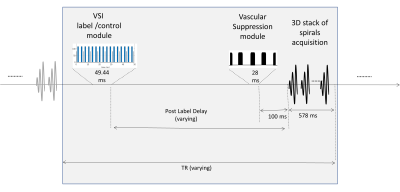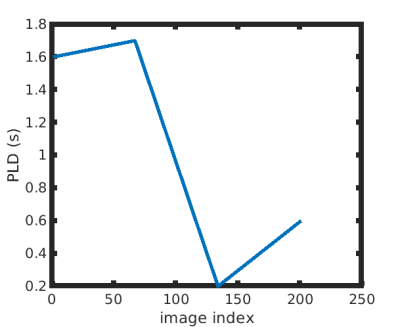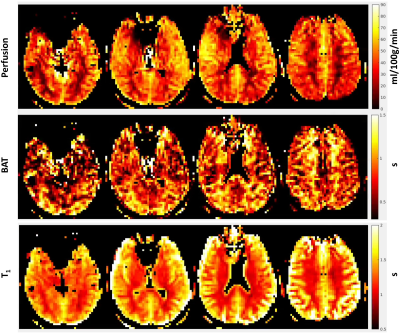2719
Perfusion Quantification using Velocity Selective Inversion pulses in a combined ASL-MRF Framework1Electrical and Computer Engineering, University of Michigan, Ann Arbor, MI, United States, 2FMRI Laboratory and Biomedical Engineering, University of Michigan, Ann Arbor, MI, United States
Synopsis
This work proposes a quantitative perfusion imaging using Velocity Selective Inversion pulses combined with an MR Fingerprinting ASL framework that allows for the alleviation of several nuisance parameters in the model, and provides hemodynamic estimates over an extensive region of the brain in a single scan. Preliminary in-vivo experiments indicate that the obtained hemodynamic estimates in gray and white matter agree with values typically found in literature.
Introduction
As a tool for quantitative perfusion measurement, MRF-based (Magnetic Resonance Fingerprinting) Arterial Spin Labeling (ASL) is gaining increasing popularity [1],[2],[3],[4] due to its ability to simultaneously yield unbiased estimates of perfusion and multiple other hemodynamic parameters and tissue properties. However, to realize its potential for use in clinical imaging, MRF-ASL needs to be able to provide unbiased estimates of perfusion for an extensive region of the brain in a relatively short period of time. This presents a challenge because shorter labeling durations inevitably result in fingerprints that contain less information about perfusion. Velocity Selective Inversion (VSI) pulses [5] have garnered attention for being particularly sensitive to perfusion, while being able to eliminate nuisance parameters like magnetization transfer from the signal model, and producing signals having reduced sensitivity to bolus arrival time (BAT) effects[6]. In this work, we aim to use VSI pulses in conjunction with an MRF-ASL framework to quantify perfusion across multiple slices of the brain. Furthermore, with the aid of Velocity Selective Saturation (VSS) pulses across all acquired images in the fingerprint, we also eliminate sensitivity of the ASL fingerprints to the Cerebral Blood Volume (CBV) fraction.Methods
In our work, the ASL preparation was done with a VSI pulse—either velocity selective (label) or non-selective (control), a variable post-labeling delay, and a VSS pulse for arterial suppression before acquisition. Fig. 1 shows a single repetition period for this method. The generated VSI pulses were based upon the method described in [7].The theorized model for our work effectively has two compartments: tissue and artery. The arterial compartment is further separated into two components, $$$M_{\text{art}}$$$ and $$$M_{\text{art-ex}}$$$, to represent fast and slow-moving spins, respectively. While there is a continuum of spin velocities in an artery, we use these compartments to segregate the spins that are fast enough to not be inverted by the selective inversion pulses from the spins that move slowly enough (especially when exchanging with tissue) to be inverted. We describe the signal in the tissue compartment as:
$$\frac{dM_{\text{tis}}(t)}{dt} = -\frac{M_{\text{tis}}^0-M_{\text{tis}}(t)}{T_{1,\text{tis}}}+f\cdot M_{\text{art-ex}}(t) - \frac{f}{\lambda}\cdot M_{\text{tis}}(t),$$
where $$$M_{\text{art-ex}}$$$ is an arterial exchange compartment that represents the blood in the artery at the exchange site, consisting of slow-moving spins, $$$f,\lambda,M_{\text{tis}}$$$ represent the perfusion, blood-brain partition coefficient and magnetization in the tissue compartment, respectively. To incorporate the effects of VSI pulses on the fast-moving spins in arterial blood, a separate compartment is included which represents the arterial blood $$$M_{\text{art}}$$$. Spins enter the arterial compartment at a ‘fast’ velocity, and slow down before exchanging into the tissue compartment after a delay. We track this behavior by modeling the fast and slow/exchanging spins separately:
$$\frac{dM_{\text{art}}(t)}{dt}=-\frac{M_{\text{art}}^0-M_{\text{art}}}{T_{1,\text{art}}}\\\frac{dM_{\text{art-ex}}(t)}{dt}=-\frac{M_{\text{art-ex}}^0-M_{\text{art-ex}}(t)}{T_{1,\text{art}}}.$$
However, at the end of every BAT, the contents of the $$$M_{\text{art}}$$$ sub-compartment transfer over to the $$$M_{\text{art-ex}}$$$ sub-compartment as follows:
$$M_{\text{art}}(t^*+\text{BAT})=M_{\text{art-ex}}(t^*+\text{BAT}),$$
where $$$t^*$$$ denotes the time at which a velocity selective pulse is applied.
To model the effects of the various velocity selective pulses we introduce three labeling efficiencies into our model, namely $$$\alpha_{\text{ti}},\alpha_{\text{ai}}~$$$and$$$~\alpha_{\text{ts}}$$$.$$$\alpha_{\text{ti}},\alpha_{\text{ai}}$$$ dictate the extent to which the VSI pulses invert spins in tissue and artery respectively, while $$$\alpha_{\text{ts}}$$$ dictates the extent of inversion in slow-moving tissue spins due to a velocity selective saturation pulse. We express these effects mathematically as:
- Velocity Selective Inversion (label)
- Velocity Selective Non-inversion (control)
- Velcity Selective Saturation
Typical values for $$$\alpha_{\text{ti}},\alpha_{\text{ai}}~$$$and$$$~\alpha_{\text{ts}}$$$ are obtained from separate Bloch simulations of the VSI pulses. Finally, the observed signal is given by:
$$s(t)=\big(\mathrm{CBV_a}\cdot M_{\text{art}}+(1-\mathrm{CBV_a})\cdot M_{\text{tis}}\big)\cdot\sin{\beta},$$ where $$$\beta$$$ is the flip angle.
We test our method by estimating perfusion, BAT and tissue $$$T_1$$$ on two healthy subjects. The PLDs in our fingerprint were varied according to the schedule in Fig. 2. The total duration for the scan was $$$600$$$s for $$$18$$$ slices across the brain. The data was acquired on a 3T GE MR750 scanner using a 32-channel Nova Medical coil. The matrix size was $$$64\times 64\times 18$$$, resolution=$$$3.5\times 3.5\times 6$$$mm3 ,TE = $$$15$$$ms, bandwidth=$$$125$$$kHz, fast spin echo stack of spirals readout.
For estimation, we used individual neural networks for each parameter with two hidden layers and $$$100$$$ nodes in each layer. The networks were trained with $$$6\times 10^6$$$ synthetic fingerprints generated from a Bloch simulation of the model described above. The ground truth parameters for the training data were varied uniformly across the range shown in Fig 3. White Gaussian noise with standard deviation of $$$0.003$$$ was added to the fingerprints during training. The ADAM algorithm [8] was used as an optimizer.
Results
Fig 4 shows the results for quantifying perfusion, BAT and $$$T_1$$$ using our proposed VSIASL+MRF technique for one human subject (4 of 18 slices). The predicted perfusion values in gray and white matter are consistent with those found in ASL literature, and the contrast between gray and white matter values is also as expected. This observation was consistent across both subjects.Conclusion
We conclude that estimation of perfusion using an MRF-ASL framework combined with VSI pulses is feasible and allows for the estimation of multiple hemodynamic parameters in the brain without hindrance from nuisance parameters, though further validation against other methods is required both in-vivo and in-silico.Acknowledgements
Michigan Alzheimer's Disease Center
NIH grant R01NS112233
References
[1] Pan Su, Deng Mao, Peiying Liu, Yang Li, Marco C Pinho, Babu G Welch, and Hanzhang Lu. Mul-tiparametric Estimation of Brain Hemodynamics With MR Fingerprinting ASL.Magn Reson Med,78:1812–1823, 2017
[2] Katherine L. Wright, Yun Jiang, Dan Ma, Douglas C. Noll, Mark A. Griswold, Vikas Gulani, and LuisHernandez-Garcia. Estimation of perfusion properties with MR Fingerprinting Arterial Spin Labeling.Magnetic Resonance Imaging, 50:68–77, 7 2018
[3] Anish Lahiri, Jeffrey A. Fessler, and Luis Hernandez-Garcia. Optimizing MRF-ASL scan design forprecise quantification of brain hemodynamics using neural network regression.Magnetic Resonance inMedicine, 83(6):1979–1991, jun 2020.
[4] Fan, H, Su, P, Huang, J, Liu, P, Lu, H. Multi‐band MR fingerprinting (MRF) ASL imaging using artificial‐neural‐network trained with high‐fidelity experimental data. Magn Reson Med. 2020; 00: 1– 12.
[5] Qin Qin and Peter C.M. van Zijl. Velocity-selective-inversion prepared arterial spin labeling.MagneticResonance in Medicine, 76(4):1136–1148, oct 2016.
[6] Luis Hernandez-Garcia, Jon-Fredrik Nielsen, and Douglas C. Noll. Improved sensitivity and temporalresolution in perfusion FMRI using velocity selective inversion ASL.Magnetic Resonance in Medicine,81(2):1004–1015, feb 2019
[7] Guo, J., Das, S. and Hernandez‐Garcia, L., Comparison of velocity‐selective arterial spin labeling schemes. Magnetic Resonance in Medicine, 2020.
[8] Kingma DP, Ba J. Adam: A method for stochastic optimization. arXiv:1412.6980. 2014, 12
Figures



